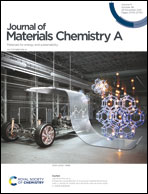Molten state synthesis of nickel phosphides: mechanism and composition-activity correlation for electrochemical applications†
Abstract
Nickel phosphides are highly attractive low-cost (electro)catalysts, thanks to their unique electronic structure, versatile phase diagram, and chemical stability. Herein, we describe a single-step, simple, and scalable synthesis of nickel phosphides, with good control over phase composition, size, and catalytic activity, by a direct thermal reaction of nickel nitrate hexahydrate and triphenylphosphine (PPh3). Advanced analytic tools combined with theoretical calculations reveal that upon heating, nickel ions are dissolved and coordinated by PPh3, enabling the synthesis of fine-tuned particles, with nickel phosphide phases ranging from Ni3P to Ni2P. The new synthetic method enables comprehending the correlation between phase composition and the phosphides' catalytic activity. This work shows a clear composition-activity trend of the optimized nickel phosphides both as electrocatalysts for the hydrogen evolution reaction in acidic media and as anode materials in Li-ion batteries.



 Please wait while we load your content...
Please wait while we load your content...